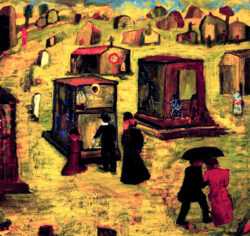Marion Souchon
New Orleans surgeon Marion Sims Souchon was also a respected self-taught artist who produced more than 500 paintings.

Courtesy of New Orleans Museum of Art
Permanent Address. Souchon, Marion (artist)
A doctor, teacher, and businessman from a prominent New Orleans family, Marion Sims Souchon turned to painting as second career in 1934 as he approached retirement. Souchon was chief surgeon at Hotel Dieu Hospital, visiting surgeon at Charity Hospital and other local hospitals, instructor at Tulane University, and one of the founders of Pan American Life Insurance Company. Initially, painting was a diversion from the pressures of being a surgeon and handling life and death situations on a daily basis, but painting quickly became a passion for the aging doctor and he felt that, due to his age, he “must hurry up.” For twenty years he exhibited locally with The Arts and Crafts Club of New Orleans, Delgado Museum of Art (today New Orleans Museum of Art), and Southern States Art League; he exhibited nationally with the Carnegie Institution, the Corcoran Gallery of Art, and the Julian Levy Gallery in New York City.
The Doctor
The son of Edmond and Corrine Lavie Souchon, Marion was born in 1870 into a family with a long line of doctors. His father was a highly regarded teacher and surgeon at Tulane University, writer for medical journals, and member of the board of administrators for Charity Hospital in New Orleans. Marion attended Springhill College in Mobile, Alabama, and the University of Virginia, and he graduated from Tulane University Medical School in 1894. From 1894 to 1896 he interned at Charity Hospital.
In 1896 Souchon married Dolly Gabrielle Burthe. They had three children: sons Edmond II and Harry, and a daughter Marion, named after her father. Edmond II followed in his father’s footsteps, becoming a doctor and a New Orleans jazz enthusiast, musician, and historian. The Souchons were active in Rex, the socially prominent Mardi Gras krewe. Daughter Marion was queen of Carnival in 1922, and Souchon’s granddaughter Dolly Ann continued the family tradition, reigning in 1949.
Souchon enjoyed a successful and productive career as a doctor. Until 1903 he was assistant demonstrator of anatomy before becoming chair of clinical surgery at Tulane University. From 1910 to 1925 he taught classes in anatomy and osteology at Tulane. He went on to serve on the board of administrators and as visiting surgeon at Charity Hospital, surgeon at Touro Shakespeare Home, chief surgeon at the French Hospital, and chief surgeon at Hotel Dieu Hospital; he held this latter position for twenty-five years.
With Crawford Ellis, Dr. Edward Simmons, and Eugene McGivney, Souchon founded the Pan American Life Insurance Company in 1911 and served as its medical director and vice president. He also had an interest in history and donated, in memory of his father, his library of more than 2,000 books to Howard Tilton Memorial Library at Tulane University.
The Artist
Initially, Souchon painted in a traditional representational style with a subdued dark palette, and his work was not well received by local art critics. He then embraced the emerging modernist movement and began to paint bold, intensely colorful paintings reminiscent of the French Fauves and German expressionists. Critics saw his paintings as modern French primitive, but Souchon described his style as “subconscious expressions.” In a December 29, 1941, Time magazine article titled “Painting Doctor,” Souchon expressed his enthusiasm for painting: “I like my pictures red hot. The only trouble with color is that you can’t eat it.”
Souchon enjoyed critical acclaim for his artwork, and the painting To the Day Nursery won first prize at the Delgado Museum of Art in 1934 and was purchased for the museum’s collection. In November 1935 the Arts and Crafts Club of New Orleans gave him his first solo show; New York City’s Julian Levy Gallery gave him a solo exhibition in 1939. Souchon’s paintings were selected for an exhibition titled A New Southern Group along with works by such talented and established artists as John McCrady, Caroline Durieux, Will Henry Stevens, Enrique Alferez, and Angela Gregory. In 1943 the Arts and Crafts Club of New Orleans organized Exhibition of Recent Paintings by Marion Souchon. The Pan American Life Insurance Company housed a large collection of Souchon’s paintings, which were displayed in the offices, conference rooms, and reception areas. Nationally, his paintings were included in exhibitions at the Carnegie Institution in 1941 and the Corcoran Gallery of Art in 1945, and his works toured with Southern States Art League. In 1951 the Delgado Museum of Art organized a solo show and then toured a selection of his paintings under the auspices of the American Federation of Art.
In 1960, six years after Souchon’s death, the 331 Gallery in the French Quarter organized an exhibition of the artist’s paintings from his family’s collection. Forty years later, in 2000, a major retrospective titled Marion Souchon: Surgeon, Professor, Businessman, Painter was organized by the New Orleans Museum of Art.
His paintings were often autobiographical, reflecting Louisiana subjects as well as the doctor’s sense of humor. Commenting on the abstract qualities, flat areas of color, faceless figures, and lack of details in his work, Souchon said, “I am interested in attitudes, not faces. Look at the lines, the attitudes. What differences do faces make?”
Souchon methodically numbered his canvases on their versos and ultimately created more than five hundred paintings. Most of his paintings were given to family and friends because he did not want to compete with local artists who sold their art for a living.
Souchon’s work is represented in many public and private collections, including the Ogden Museum of Southern Art, The Historic New Orleans Collection, the New Orleans Museum of Art, and the Morris Museum of Art in Augusta, Georgia.
